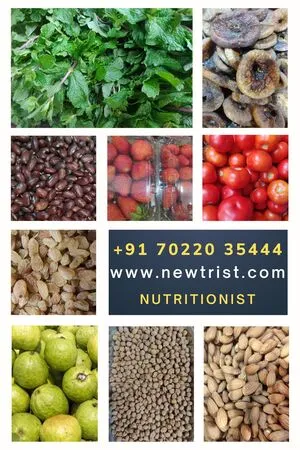Newtrist Nutritionist Aplastic Anemia diet plan consists of iron-rich foods such as dark leafy greens, peas, lentils, beans, whole grains, dry fruits, soy foods, iron-fortified cereals, lean meats such as chicken, turkey, fish, eggs, red meats, organ meats, liver, and pasteurized dairy products.
- Early morning drink @ 6:30 am: Overnight soaked figs with peeled almonds
- Breakfast @ 9 am: Brown bread chicken sandwich with 1 small guava
- Mid-morning meal @ 11 am: Healthy fruit salad (orange, kiwi, grapes, and strawberries)
- Lunch @ 1 pm: Steamed rice with rajma curry and fish fry (shallow-fried)
- Evening snack @ 4 pm: Soaked poha with jaggery, raisins, and grated coconut
- Dinner @ 7 pm: Spinach uthappam with mint/tomato chutney
Consult 19 years experienced Chief Nutritionist Vasanthi for expert advice and a personalized diet plan. In-person consultation at HSR, Koramangala, Bellandur, Haralur, and video consultation across India.
- Consultation INR 750
- 1 Week personalized diet plan INR 2000
- 1 Month personalized diet plan INR 4000
- 3 Months personalized diet plan INR 9000

Table of Contents
What is Aplastic Anemia?
Aplastic anemia is a rare autoimmune condition that develops due to damage to bone marrow and an insufficient supply of red blood cells. This disease occurs mostly after the age of 60. Toxic chemicals, pollutants, exposure to radiation, and chemotherapy may be some of the causes of aplastic anemia.
People with aplastic anemia are at risk of developing paroxysmal hemoglobinuria syndrome (PHS), a failure of the bone marrow disorder which is characterized by the rapid breakdown of the red blood cells.
Destruction of stem cells affects the production of red blood cells in the bone marrow. Stem cells are sponge-like tissues within the bone marrow that are responsible for the synthesis of red blood cells. The stem cells in the bone marrow are attacked by the body’s immune system which affects the bone marrow and leads to reduced or nil production of red blood cells. Aplastic anemia may increase the risk of leukemia, prolonged clotting time, and other blood-related conditions.
What are the symptoms of Aplastic Anemia?
The symptoms of Aplastic anemia are
- Tiredness
- Shortness of breath
- Easily susceptible to infections
- Bleeding in the nose and gums
- Delayed clotting time
- Paleness of the skin and face
- Irregular heartbeat
- Weakness
- Headache
- Fever
- Easy bruising of the skin.
The symptoms may be mild to moderate depending upon the severity of the disease. The symptoms vary from person to person and are an indication to seek the help of a health care professional for medical advice.
Radiation treatments and chemotherapies destroy even the stem cells in addition to cancer cells which may be the major cause of Aplastic anemia. Treatment for rheumatoid arthritis can cause aplastic anemia. Viral infections, autoimmune disorders, and exposure to toxins and pollutants may increase the prevalence of aplastic anemia.
What are the stages of Aplastic Anemia?
The 3 stages of aplastic anemia are
· Non-severe aplastic anemia
· Severe aplastic anemia
· Very severe aplastic anemia
What is Non-severe aplastic anemia (NSAA)?
Non-severe aplastic anemia is a rare condition that does not meet the criteria for severe/very severe aplastic anemia. Mild forms of aplastic anemia need no treatment, it can be managed with a healthy diet to improve the production of red blood cells, white blood cells, and platelets.
What is Severe aplastic anemia (SAA)?
Severe aplastic anemia is a severe form of aplastic anemia where the symptoms start to progress to the next level. Untreated aplastic anemia may be life-threatening.
What is Very Severe Aplastic Anemia (VSAA)?
Very severe Aplastic anemia needs immediate medical attention as this kind of anemia contributes to very high death rates.
What are the types of Aplastic Anemia?
The two types of Aplastic anemia are
· Inherited Aplastic anemia
· Acquired Aplastic anemia
What is Inherited Aplastic anemia?
Inherited Aplastic anemia is commonly found in children and young adults which is caused due to the random mutation of the genes. Fanconi anemia is a rare recessive condition inherited from families characterized by the decreased production of red blood cells.
What is Acquired Aplastic anemia?
Acquired Aplastic anemia is observed in younger and older adults which is caused due to changes in the immune system. Certain viral infections, HIV infections, and Hepatitis viral infections may be the reason for acquired aplastic anemia.
Aplastic Anemia Diet Plan
Aplastic anemia diet plan consists of iron-rich foods such as spinach and dark green leafy vegetables, foods rich in vitamins B12, C, and Folic acid. Vitamin C is very crucial for the absorption of iron in the body. Ensure your meal contains rich sources of vitamin C such as citrus fruits, leafy greens, and fresh vegetables.
A balanced diet enriched with vitamins and minerals helps to manage the severity of the symptoms. Organically grown fruits, vegetables, and grass-fed meats help you to lead a pesticide-free life and improve the symptoms of Aplastic anemia.
- Early morning drink @ 6:30 am: Wheat grass powder in warm water
- Breakfast @ 9 am: Avocado toast with tofu scramble
- Mid-morning meal @ 11 am: Unsweetened pomegranate juice with 4-5 dates
- Lunch @ 1 pm: Rice with turkey curry and liver stir-fry
- Evening snack @ 4 pm: Boiled eggs/Healthy trail mix
- Dinner @ 7 pm: Multigrain roti with chickpea-potato curry

Foods to Avoid with Aplastic Anemia
Foods to avoid with Aplastic Anemia include
- Refined foods
- Unpasteurized dairy products
- Undercooked/raw meats
- Caffeinated drinks
- Sugary beverages
- Peanuts
- Green tea
- Chocolates
- Bakery products
- Sodas
These foods deteriorate overall health and block the absorption of iron from the foods. wash all the fruits and vegetables well with a solution of vinegar and water to remove the pesticides and fertilizers used to grow them. Avoid foods high in vitamin K such as green tea which can worsen the condition.
Best vegetables for Aplastic Anemia
The best vegetables for Aplastic Anemia are
- Spinach
- Moringa leaves
- Broccoli
- Carrots
- Beetroots
- Sweet potatoes
- Peas
- Pumpkins
- Bell peppers
- Green beans
- Tomatoes
A healthy diet emphasizes fiber-rich foods, proteins, vitamins, and minerals before and after treatment to manage the side effects and fight treatment-related fatigue. A balanced meal helps in the synthesis of new red blood cells in the bone marrow. A variety of colored vegetables provides you with the necessary nutrients to fight the symptoms of Aplastic anemia.
Best fruits for Aplastic Anemia
The best fruits for Aplastic Anemia are
- Pomegranates
- Bananas
- Figs
- Dates
- raisins
- Custard apples
- Amlas
- Jackfruit
- Pineapples
- Lemons
- Avocados
- Strawberries
- Watermelons
Pomegranates are rich sources of iron, vitamins A, C, and E, and folic acid which increases the iron levels and the production of red blood cells in the body. Figs are good sources of iron, vitamin A, magnesium, and folate. Consistent consumption of bananas helps in the generation of healthy red blood cells and improves hemoglobin levels.

Dates are excellent sources of iron, fiber, calcium, potassium, magnesium, zinc, vitamin A, and folate which provide numerous benefits. Lycopene and beta-carotene are the two main components of watermelon that promote iron absorption in the body. Raisins contain double the amount of iron when compared to grapes. Moreover, raisins contain carbohydrates, potassium, B vitamins, and antioxidants that contribute to the formation of new blood cells.
Tips for Aplastic Anemia
Below are some of the tips for Aplastic anemia
- Choose wisely over your food choices so that all the nutritional requirements are met.
- Maintain a healthy weight. Assess your BMI and BMR with the help of our BMI and BMR calculators to check your appropriate weight.
- Focus on a vitamin and mineral-rich diet
- Include foods from animal origin for good quality iron sources a couple of times a week
- Drink ample amounts of water to keep yourself hydrated and flush out the toxins from the body. 8-10 glasses of water should be consumed daily.
- Ensure the grains and legumes you consume are mostly unprocessed and unrefined to reap maximum benefits
- Stay away from processed foods, refined foods, starchy foods, preserved foods with loads of salt, and fried foods
- Limit caffeinated drinks such as coffee, tea, green tea, sports drinks, energy drinks, and chocolates as caffeine contains diuretic properties and it interferes with the absorption of iron from the foods
- Avoid foods with added sugars such as sweets, desserts, sodas, and sweetened fruit juices
- Stay away from homemade fermented drinks and non-pasteurized milk products
- Refrain from eating raw foods, undercooked meats, half-boiled eggs, and raw sprouts
- Wash fruits and vegetables well under running water before cooking to get rid of any pesticides and insecticides on their skin surface. Peel the fruits before consumption
- Maintain hygiene on your kitchen countertops and hands to avoid the risk of infections
- Avoid leaving the foods unattended for more than 2 hours. Throw away any leftovers within 24 hours.
Foods to Prevent Aplastic Anemia
Aplastic Anemia is an autoimmune disease and no particular food can prevent the disease. Healthier food choices which include leafy greens, fully cooked meats, peas, lentils, chickpeas, nuts, pasteurized milk products, organ meats, liver, and eggs can lessen the symptoms of the disease. Including foods rich in iron, protein, folic acid, and vitamin C helps in the synthesis of new red blood cells which fights the symptoms like fatigue, weakness, headache, and dizziness of aplastic anemia.
The iron source obtained from iron-rich foods is used by the bone marrow to produce healthy cells. High-quality iron is found in animal sources such as liver, organ meats, and shellfish. Include a wide range of fruits rich in vitamin C as it is a much-needed vitamin for iron absorption.
Staying away from exposure to toxic chemicals, insecticides, pesticides, organic solvents, and thinners used to remove paints reduces the risk of the disease.
Maintaining a healthy bone marrow keeps many blood-related diseases at bay. Red and white blood cells are produced by the stem cells in the bone marrow. When there is damage in the stem cells of the bone marrow, it results in Aplastic anemia.
Aplastic Anemia FAQs
What are the best foods to eat for Aplastic Anemia?
Fiber-rich foods such as spinach, drumstick leaves, peas, lentils, unprocessed grains, soy foods, dry fruits, pasteurized dairy products, lean chicken, grass-fed meats, liver, fish, organic eggs, and fortified cereals are some of the best foods to eat for aplastic anemia. A balanced nutritious diet is advised to overcome the symptoms of aplastic anemia and the side effects of treatment.
How can I reduce Aplastic Anemia?
Preventing exposure to pesticides, insecticides, organic solvents, thinners, and other toxic chemicals can reduce the risk of aplastic anemia. Adequate rest and protecting yourself from germs and viruses can reduce aplastic anemia.
Are vitamins and calcium good for Aplastic Anemia?
Vitamins A, B12, and C are good for aplastic anemia. Vitamin B12 is abundantly found in poultry, liver, fish, and cereals fortified with vitamin B12. Foods rich in folic acid make the bone marrow produce more red blood cells. Vitamin C promotes the absorption of iron from the food. Vitamin C is naturally found in citrus fruits, spinach, broccoli, and leafy greens that facilitate iron absorption.
What are the first signs of Aplastic Anemia?
Fatigue, shortness of breath, irregular heart rate, frequent infections, prolonged clotting time, easy bruising, bleeding of the nose and gums, pale skin, fever, dizziness, and headache are a few first signs of aplastic anemia. The symptoms differ from person to person depending upon the severity of the disease. Early stages of the disease may show mild symptoms or may be asymptomatic.
Is Aplastic Anemia a serious condition?
Yes, Aplastic anemia is a serious condition that occurs when the bone marrow is unable to produce sufficient red blood cells. Lack of red blood cells may pose serious health defects in an individual. The disease starts to show symptoms only when the red blood cell count lowers which may require blood transfusions to improve the platelet count. Prompt care and treatment can help a person recover from a serious illness.